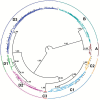Admixture between historically isolated mitochondrial lineages in captive Western gorillas: recommendations for future management
- PMID: 25790828
- PMCID: PMC4406269
- DOI: 10.1093/jhered/esv006
Admixture between historically isolated mitochondrial lineages in captive Western gorillas: recommendations for future management
Abstract
Although captive populations of western gorilla have been maintained in the United States for over a century, little is known about the geographic origins and genetic composition of the current zoo population. Furthermore, although previous mitochondrial analyses have shown that free-range gorilla populations exhibit substantial regional differentiation, nothing is known of the extent to which this variation has been preserved in captive populations. To address these questions, we combined 379 pedigree records with data from 52 mitochondrial sequences to infer individual haplogroup affiliations, geographical origin of wild founders and instances of inter-breeding between haplogroups in the United States captive gorilla population. We show that the current captive population contains all major mitochondrial lineages found within wild western lowland gorillas. Levels of haplotype diversity are also comparable to those found in wild populations. However, the majority of captive gorilla matings have occurred between individuals with different haplogroup affiliations. Although restricting crosses to individuals within the same haplogroup would preserve the phylogeographic structure present in the wild, careful management of captive populations is required to minimize the risk of drift and inbreeding. However, when captive animals are released back into the wild, we recommend that efforts should be made to preserve natural phylogeographic structure.
Keywords: Captive gorillas; Conservation; Great apes; Mitochondrial diversity.
© The American Genetic Association 2015. All rights reserved. For permissions, please e-mail: journals.permissions@oup.com.
Figures



References
-
- Ackermann RR, Bishop JM. 2010. Morphological and molecular evidence reveals recent hybridization between gorilla taxa. Evolution. 64:271–290. - PubMed
-
- Anthony NM, Clifford SL, Bawe-Johnson M, Abernethy KA, Bruford MW, Wickings EJ. 2007. Distinguishing gorilla mitochondrial sequences from nuclear integrations and PCR recombinants: guidelines for their diagnosis in complex sequence databases. Mol Phylogenet Evol. 43:553–566. - PubMed
-
- Baker CS. 2013. Journal of heredity adopts joint data archiving policy. J Hered. 104:1. - PubMed
-
- Bermejo M, Rodríguez-Teijeiro JD, Illera G, Barroso A, Vilà C, Walsh PD. 2006. Ebola outbreak killed 5000 gorillas. Science. 314:1564. - PubMed
Publication types
MeSH terms
Substances
Grants and funding
LinkOut - more resources
Full Text Sources
Other Literature Sources

